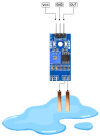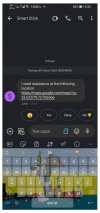IoT Enabled Intelligent Stick for Visually Impaired People for Obstacle Recognition
- PMID: 36433511
- PMCID: PMC9698640
- DOI: 10.3390/s22228914
IoT Enabled Intelligent Stick for Visually Impaired People for Obstacle Recognition
Abstract
This paper presents the design, development, and testing of an IoT-enabled smart stick for visually impaired people to navigate the outside environment with the ability to detect and warn about obstacles. The proposed design employs ultrasonic sensors for obstacle detection, a water sensor for sensing the puddles and wet surfaces in the user's path, and a high-definition video camera integrated with object recognition. Furthermore, the user is signaled about various hindrances and objects using voice feedback through earphones after accurately detecting and identifying objects. The proposed smart stick has two modes; one uses ultrasonic sensors for detection and feedback through vibration motors to inform about the direction of the obstacle, and the second mode is the detection and recognition of obstacles and providing voice feedback. The proposed system allows for switching between the two modes depending on the environment and personal preference. Moreover, the latitude/longitude values of the user are captured and uploaded to the IoT platform for effective tracking via global positioning system (GPS)/global system for mobile communication (GSM) modules, which enable the live location of the user/stick to be monitored on the IoT dashboard. A panic button is also provided for emergency assistance by generating a request signal in the form of an SMS containing a Google maps link generated with latitude and longitude coordinates and sent through an IoT-enabled environment. The smart stick has been designed to be lightweight, waterproof, size adjustable, and has long battery life. The overall design ensures energy efficiency, portability, stability, ease of access, and robust features.
Keywords: Internet of Things; biomedical device; obstacle detection; smart stick.
Conflict of interest statement
The authors declare no conflict of interests.
Figures














References
-
- Wolrd Health Organization Blindness and Vision Impairment. 2021. [(accessed on 29 March 2022)]. Available online: https://www.who.int/news-room/fact-sheets/detail/blindness-and-visual-im....
-
- Roseli N.H.M., Aziz N., Mutalib A.A. The enhancement of assistive courseware for visually impaired learners; Proceedings of the IEEE 2010 International Symposium on Information Technology; Kuala Lumpur, Malaysia. 15–17 June 2010; pp. 1–6.
-
- Kumar S.S., Abarna J., Lavanya G., Lakshmi S.N. Embedded glove to aid the visually impaired. Int. J. Electr. Electron. Data Commun. 2013;1:6–11.
-
- Wahab M.H.A., Talib A.A., Kadir H.A., Johari A., Noraziah A., Sidek R.M., Mutalib A.A. Smart cane: Assistive cane for visually-impaired people. arXiv. 20111110.5156
-
- Gbenga D.E., Shani A.I., Adekunle A.L. Smart walking stick for visually impaired people using ultrasonic sensors and Arduino. Int. J. Eng. Technol. 2017;9:3435–3447. doi: 10.21817/ijet/2017/v9i5/170905302. - DOI
MeSH terms
Grants and funding
LinkOut - more resources
Full Text Sources
Medical

